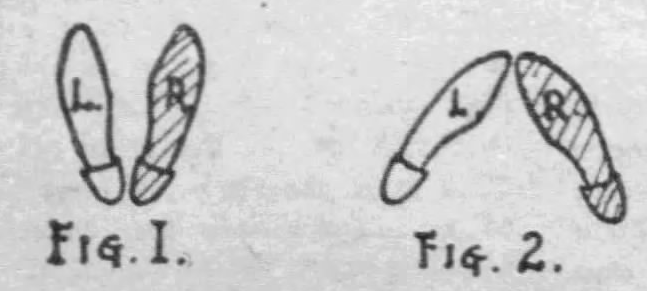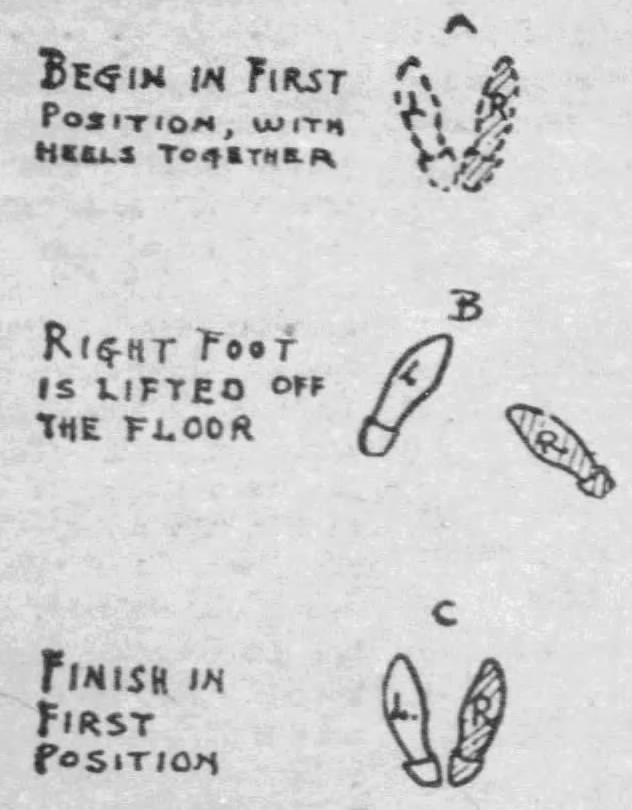Charleston
(1923 - Present)
The 1920s
The Styling
- Charleston Styling: On every odd beat (1, 3, 5, 7), when the actual steps (and touches) occur, the toes are turned out (see 1 and 3 below). On every even beat (2, 4, 6, 8), when the feet are moving between steps, the toes are turned in (see 2 below) [OD23, AM26a, AM26b, BW26]. In addition, "a toddle movement (a double rise or jiggle of the body up and down)" is used throughout all of the steps. (In the same source, however, it is noted that "discretion should be used as to how pronounced the Charleston [...] movements are made for ballroom dancing.") [OD23]. While most sources consider this styling to be essential to the Charleston, others don't mention it at all [PN25].



The Steps
- Single Charleston: Touch left toes forward (1), touch left toes back (3). This can also be done on the right foot [OD23, AM26b].
- Double Charleston: Touch left toes forward (1), step back left (3), touch right toes back (5), step forward right (7) [OD23, AM26b, BW26, NW26]. Also known in some sources as the "Single Charleston" or "Simple Charleston" [PN25].
- Cross Step: A variation of the Double Charleston in which the right foot is crossed in front on the fourth movement, traveling slightly to the left. Another version has a reversed Double Charleston (which starts with right foot touching forward) which ends with the left crossing in front of right on the fourth movement, traveling to the right [BW26].
- Double Charleston [#2]: A Double Charleston with three touches before the step: touch left toes forward (1), toes left toes back (3), touch left toes forward (5), step back left (7) [PN25].
- Charleston Walk: A slow walk forward (1, 3, 5, 7) [OD23, PN25, AM26a, AM26b, BW26, NW26]. Charleston styling often applies [AM26a, AM26b, BW26], but not always [NW26]. Sometimes described as a crossing walk, in which the stepping foot crosses the stationary foot [AM26b]. One source describes a toe (1), heel (2) version of the walk [PN25]. Perhaps followed by a Single Charleston ("Routine I") [OD23], or a Double Charleston ("Routine II") [OD23, NW26]. The Charleston Walk can also be done backing the Lead [BW26].

- The Double Walking Charleston: Touch forward left, with twist (1), then without moving the feet, twist again, taking weight (3). Then do the same thing on the right foot, continuing to move forward (5, 7) [AM26c].
- Traveling Double Charleston: Touch left forward (1), touch left back (3), step left forward (5), touch right forward (7), touch right back (1), step right forward (3), touch left forward (5), touch left back (7), step left forward (1), touch right forward (3), touch right back (5), step right forward (7) [BW26].
- Single Charleston, Forward and Back: Step forward left, step forward right, touch forward left, step back left. Then step backward right, step backward left, touch backward right, and step forward right [BW26].
- The Swinging Step: Step forward left (1), and swing right forward off the floor. Then step back right, and swing left back off the floor (7). No Charleston styling specified [NW26].
- The Collegiate Charleston: A variation of the Swinging Step: step forward left (1) and lift right forward (4 inches off the floor), crossed six inches in front of left (3). Then step back right (5) and lift left backward, crossed behind right (4). The Follow's directions are opposite and her crosses are parallel to the Leads'. In this variation, the usual Charleston styling applies [AM26c].
- Charleston Chasse: Step side left (1), close right to left (3). The usual Charleston styling applies [AM26c].
- The Murray Charleston: Touch side left (1), and step forward left, left foot in front of right (3). Then touch side right (5), and step forward right, right foot in front of left (7). The usual Charleston styling applies [AM26c].
- The Figure 8 Right: Step forward left (1), diagonally forward right (2), cross left in front of right (3), step diagonally back right (4), step back left (5), cross right behind left (6), step side left (7), and step forward right to where you started. No Charleston styling, just basic steps [NW26].
- The Figure 8 Left: Step forward left (1), cross right in front of left (2), step side left (3), step right behind left (4), cross left behind right (5), step side right (6), cross left behind right (7), and step forward right to where you started (8). No Charleston styling, just basic steps [NW26].
- Charleston Polka: Side left (1), close right to left (2), side left (3), touch (or strike) right toe to the floor (4), then touch (or strike) right heel (5), toe (6), heel (7), toe (8). Then repeat to the right [NW26].
- In Place: With weight on right foot, touch heels together twice (1, 3), raising left foot slightly behind before each touch, and taking weight the second time. Then repeat with the right foot (5, 7) [NW26]. Described as following a Cross Step to the left.
- Side Step Left: With weight on right, touch heels together in place (1), step side left (3), and touch heels together twice in place (5, 7) [NW26].
- Side Step Right: With weight on left, touch heels together in place (1), step side right (3), and touch heels together twice in place (5, 7) [NW26].
- Routine III: Two steps forward (1, 3), followed by a two-step to the left (5, 6, 7), followed by a "kick up" of the right foot behind from the knee. Then a two-step and "kick up" to the right (1, 2, 3), followed by a Single Charleston of the left, touching forward and back (5, 7) [OD23].

- Single Charleston Travel (Simple Charleston Sur Le Côté): Small step forward on right foot (1), touch left forward (3), step side left (5), close right instep to left heel (7) [PN25]
- Side Step (Pas de Côté): Step side right (1), then "strongly beat" the left knee and foot against the right knee and foot (3). Then repeat opposite, to the left (5, 7) [PN25]
Learning the Charleston
According to Arthur Murray, there are four stages to learning the Charleston style [AM26a]:
- First Stage: Start with heels together, toes apart (Fig. 1). Spread heels apart and touch toes together (Fig. 2) (count 1), then return the original position (count 2).

- Second Stage: Same twisting action as First Stage, but lifting the right foot off the floor (slightly, no more than two inches) when you spread the heels apart (count 1), and bringing it back down when you bring heels together (count 2). Even though only one foot is being lifted, make sure that both heels and both toes are moving.

- Third Stage: Same as the Second Stage, but lifting the left foot instead of the right.
- Fourth Stage: Same as the Second Stage, but alternating which foot is lifted: first the right, and then the left.
Around the same time, Ned Wayburn suggested a similar exercise, but with the opposite emphasis: bring the heels together on the odd counts, and apart on the even counts. This is an even better exercise, because it's how it actually works in the dance [NW26]. Practice doing this with your weight on your right foot, then your left foot. Then practice doing it while touching the free foot in various directions (in front, to the side, behind).
Sources
- OD23 — Oscar Duryea. (1923). Charleston Fox Trot accompanying sheet music for The Original Charleston. New York.
- PN25 — Pradère-Niquet. (1925). Théorie du Charleston accompanying sheet music for The Original Charleston. Paris.
- AM26a — Arthur Murray. (1926, January 10). "The Charleston." The Sunday American-Statesman Magazine (Austin, TX).
- AM26b — Arthur Murray. (1926, January 10). "Advanced Steps of the Charleston." The Atlanta Constitution (Atlanta, GA).
- AM26c — Arthur Murray. (1926, February 14). "The Society Charleston." The Atlanta Constitution (Atlanta, GA).
- BW26 — Bemis Walker. (1926). How To Charleston Correctly. Minneapolis.
- NW26 — Ned Wayburn. (1926). How to Dance Ned Wayburn's Ballroom Charleston. New York.
© 2018 Nick Enge
For more dance descriptions, see our three books on dancing:
The Book of Mixers: 100 Easy-Teach Dances for Getting Acquainted (2022) by Richard Powers and Nick & Melissa Enge,
Cross-Step Waltz: A Dancer's Guide (2019) by Richard Powers and Nick & Melissa Enge, and
Waltzing: A Manual for Dancing and Living (2013) by Richard Powers and Nick Enge.
For full-length teaching videos, visit: University of Dance.
For help crafting a life you love, visit: Project Quartz.
Home About Dances Manuals Search









